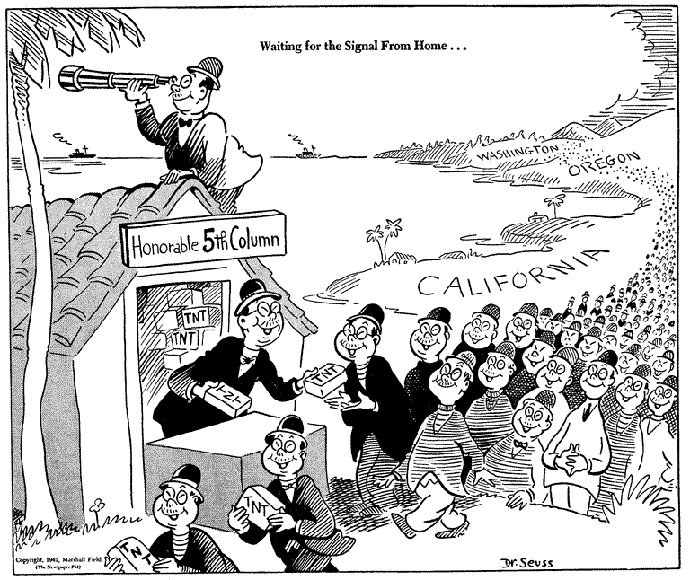What is Propaganda?
According to Oxford Dictionary, propaganda is “information, especially of a biased or misleading nature, used to promote or publicize a particular political cause or point of view.” Propaganda is everywhere, and we are all influenced by it in some way. In times of war, the use of propaganda is more intense. During World War II, propaganda was used to sell war bonds, promote women workers, and show American strength. But propaganda had a negative affect. It degraded Japanese Americans. Propaganda depicted the Japanese as unitelligent, sub-human-like monsters. This created fear, a lack of respect and the idea of superiority in the American public.
 This particular cartoon (right), drawn by Theodor Geisel, or better known as Dr Seuss, is an example of American perception of Japanese. After Pearl Harbor, many Americans thought that the Japanese Americans were waiting for a sign from the homeland to attack the U.S. People were fearful that the Japanese Americans were spying on the U.S. government and reporting back to Japan. Cartoons like this one, only persuaded U.S. citizens that the Japanese Americans were the enemy: that they deserved to be taken to the internment camps. Geisel himself, was a strong supporter of the internment camps and was very anti-Japanese in general. After visiting Japan after the bombings of Hiroshima and Nagasaki, his perception of the Japanese was changed. He later went on to write Horton Hears a Who!, which served as an apology to the Japanese people.
This particular cartoon (right), drawn by Theodor Geisel, or better known as Dr Seuss, is an example of American perception of Japanese. After Pearl Harbor, many Americans thought that the Japanese Americans were waiting for a sign from the homeland to attack the U.S. People were fearful that the Japanese Americans were spying on the U.S. government and reporting back to Japan. Cartoons like this one, only persuaded U.S. citizens that the Japanese Americans were the enemy: that they deserved to be taken to the internment camps. Geisel himself, was a strong supporter of the internment camps and was very anti-Japanese in general. After visiting Japan after the bombings of Hiroshima and Nagasaki, his perception of the Japanese was changed. He later went on to write Horton Hears a Who!, which served as an apology to the Japanese people.
 Negative depiction of Japanese continued into television cartoons. Animated cartoons targeted not only adults, but also children and adolescents. One of the most famous cartoons was Bugs Bunny Nips the Nips (http://vimeo.com/93867189). In this cartoon, Bugs Bunny battles the Japanese, and of course wins through his clever trickery. The Japanese, in this cartoon, are called all sorts of derogatory names, such as slant eyes, boat legs, etc. The Japanese are also depicted as unintelligent, allowing Bugs Bunny to beat them quite easily. Other cartoons also used this format. Popeye and Donald Duck are some examples. Again, in these cartoons, the “hero” (representing American power) over powers the “Japs” through cleverness and strength.
Negative depiction of Japanese continued into television cartoons. Animated cartoons targeted not only adults, but also children and adolescents. One of the most famous cartoons was Bugs Bunny Nips the Nips (http://vimeo.com/93867189). In this cartoon, Bugs Bunny battles the Japanese, and of course wins through his clever trickery. The Japanese, in this cartoon, are called all sorts of derogatory names, such as slant eyes, boat legs, etc. The Japanese are also depicted as unintelligent, allowing Bugs Bunny to beat them quite easily. Other cartoons also used this format. Popeye and Donald Duck are some examples. Again, in these cartoons, the “hero” (representing American power) over powers the “Japs” through cleverness and strength.
 Propaganda not only represented the Japanese as unintelligent, but also represented the Japanese as cunning monsters. The Japanese were drawn in an ape-like fashion with fangs dripping in drool and knives hidden behind their backs. They were also portrayed as vicious; pursuing and scaring young American women. This inspired fear in the people, who then saw the Japanese Americans as a threat to the safety of the United States.
Propaganda not only represented the Japanese as unintelligent, but also represented the Japanese as cunning monsters. The Japanese were drawn in an ape-like fashion with fangs dripping in drool and knives hidden behind their backs. They were also portrayed as vicious; pursuing and scaring young American women. This inspired fear in the people, who then saw the Japanese Americans as a threat to the safety of the United States.
The Japanese Americans were innocent in this whole ordeal. They were loyal to the U.S. but were not trusted due to their race. The Japanese Americans were unfairly judged by negative representation in propaganda. Unfortunately, the people and the government were blinded by stereotypes, and American citizens suffered the consequences.
~Bridget
Works Cited
Browne, Alex. "How the USA’s Racist World War Two Propaganda Campaign Depicted the Japanese as Subhuman." Made From History. N.p., n.d. Web.
"Dr. Seuss's Racist Anti-Japanese Propaganda (And His Apology)." Tofugu. N.p., n.d. Web. 07 Dec. 2014.
Miles, Hannah. "WWII Propaganda: The Influence of Racism." Artifacts Journal RSS. University of Missouri, n.d. Web. 07 Dec. 2014.
No comments:
Post a Comment